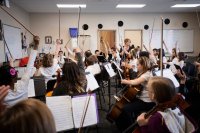Building a Sense of Community With Music
How a music program can fortify peer relationships and increase parent engagement and community involvement.
Community is a fundamental aspect of our experience of music—it tends to unite people, forming bonds that might not exist otherwise. It connects different cultures, promoting diversity and growth. Music encourages creative thinking, discipline, leadership, and problem solving. And it’s a medium for individual and group expression—as Hans Christian Andersen said, “Where words fail, music speaks.”
I’ve seen music bring a sense of community. In 2012, I began building a music program from the ground up at a Title I charter school in Mansfield, Ohio. The school was small, with just 88 students, and the poverty rate was around 90 percent. As I got to know my students, I learned that many of them came from broken homes and broken relationships.
The school previously had no general music, no band, no musical performance—no musical traditions at all. I wasn’t sure how to begin, but I had a vision in my mind: My classroom would be a place where students felt safe to express themselves, and they would have a wealth of musical instruments and knowledge at their disposal to do so.
I made many trips to Stanton’s Music in Columbus, Ohio, to build a collection of sheet music; we received grants for music tech, instruments, and more from the Richland County Foundation; and SterrySong here in Mansfield donated instruments. With these resources, the music department began to grow.
Over time I learned to relate to my students based on their popular music interests. They were especially excited to perform “This Is Me” from the movie The Greatest Showman and “Thunder” by the band Imagine Dragons. These pieces were easily incorporated in lessons and practice, which developed the trust and comfort I sought. Students became comfortable enough to share some of their original compositions with the class, and encouraged each other to perform the originals at concerts. Once the students were on board, the community took off.
Mallet Madness
One of our biggest shows, Mallet Madness, is a huge community effort. (It’s not connected with the book of the same name). This concert is built around passionate fourth and fifth graders singing and playing Orff instruments, which are used in Orff Schulwerk, a developmental approach in music education that combines music, movement, drama, and speech into lessons that are similar to a child’s world of play. Orff instruments include xylophones, glockenspiels, marimbas, and metallophones.
Everyone in the school really leans on one another to orchestrate this event. Teachers collaborate to add visual effects and ideas, and they run sound, make music videos, and stop in to rehearsals to encourage students. Our art teacher helped design T-shirts with an event logo so the students would look like a team, and the dance teachers poured their heart and soul into the choreography for the concert.
Mallet Madness is all about community, so this year we decided replace tickets sales with a food drive—we asked the parents of the students performing to bring a canned good to donate to our local food pantries. So students learned about supporting their community while they were learning about music.
A Sense of Community Develops
I went from begging parents to come see performances five years ago to having 500 audience members cheering their children on this past year. Alumni returned to enjoy the show, and some performed with the students.
The students’ pride in and sense of ownership of their music has grown over the years. I always give notes after a rehearsal, but where it used to be just me talking, it’s now a student-centered conversation, a brain trust of mutual support and constructive criticism. Some students even schedule practice outside of school. This year, I started leaving encouraging messages for students backstage, and within months I noticed that students were writing similar messages to each other.
I’ve seen my students in tears while performing because of the friendships they’ve formed and the bonds developed through music. Such dedication and vulnerability is the community standard. As they break down their walls and share their passions, they see that they can do anything they put their minds to.
Since 2012, our student body has gone from 88 to over 300, and every student performs music for an audience. We now have two concert bands, a rock ensemble, a concert choir, an a cappella choir, a bucket drumming ensemble, and an Orff ensemble. And we have an annual recital in which every eighth-grade student performs on a grand piano.
